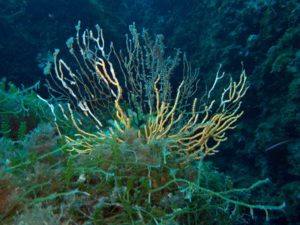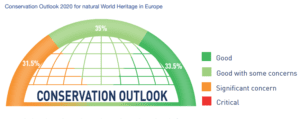IUCN report: Climate change is the top threat to natural World Heritage
IUCN World Heritage Outlook 3
According to the new report “IUCN World Heritage Outlook 3“, climate change now represents the biggest danger to natural World Heritage sites – threatening a third (33%) of these sites.
Climate change threatening the World Heritage
Building on previous reports from 2014 and 2017, the IUCN World Heritage Outlook 3 tracks the improvements or worsening of conservation in the world’s 252 natural World Heritage sites. It then classifies the individual sites according to whether their conservation is sufficient to protect them in the long term. Additionally, the report identifies the biggest threats.
In the new report, climate change has overtaken invasive species as the top threat to natural World Heritage.
From shrinking glaciers to coral bleaching to increasingly frequent and severe fires and droughts, climate change is affecting the world’s most precious and irreplaceable places. Among the 83 natural World Heritage sites seriously threatened by climate change is for example the Great Barrier Reef in Australia, where ocean warming, acidification and extreme weather contribute to dramatic coral decline.

Mortality events on Gorgonian corals. Photo: Lorenzo Merotto
While the international community sets new objectives to conserve biodiversity and fight climate change, the report signals the urgency to address the environmental challenges NOW and at the global scale.
Download the IUCN World Heritage Outlook here
One of the gloomiest figures resulting from the report concerns the quality of protection and management. The Outlook finds that 16 natural World Heritage sites have deteriorated since 2017, while only eight have improved.
How is Europe doing?
The report found the following about the conservation in the 54 natural and mixed World Heritage sites in Europe:
- for one-third (33.5%) the conservation outlook is “good”,
- for just over one-third (35%) the conservation outlook is “good with some concerns”,
- for just under one-third (31.5% ) the conservation outlook is assessed as “significant concern”,
- there are no sites in Europe for which the conservation outlook is assessed as “critical”.

Source: IUCN World Heritage Outlook 3, page 60
As for the threats, the most prevalent threat to European World Heritage sites is currently climate change, followed by invasive species and impacts from tourism and visitation.
On the brighter side, the Outlook found an improvement compared to 2017, with the percentage of European sites assessed as having highly or mostly effective protection and management increasing from 49% to 54%.
Hope for the future
The findings of the report point to one clear conclusion: there is an urgent need for adequate resources to manage the most precious places on our planet, if we want to protect them efficiently and preserve them for the future generations.
Some of the sites that managed to improve their conservation score over time, represent great hope for the future. Peter Shadie, the Director of IUCN’s World Heritage Programme, said:
Many natural World Heritage sites show that conservation can and does work for the greater good, and their achievements serve as models that can be replicated and scaled up elsewhere.
With climate change posing such a great threat to our natural heritage, EUROPARC is happy to be part of the ambitious project “Natur’Adapt”. Natur’Adapt aims at triggering a transition towards the adaptive management of Protected Areas while laying the foundations of a dynamic collective learning process.
Visit the new section on climate change on our website, read about the Natur’Adapt project and discover more inspiring resources on the topic!
